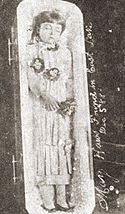Hawes murders
The Hawes murders were a notorious and sensational crime discovered in December 1888 that produced a deadly riot and gained nationwide media attention for the young city of Birmingham. The victims were Emma Hawes and her two daughters, May, 7, and Irene, 6. They were killed by Richard Hawes, a Georgia-Pacific engineer who lived on 32nd Street South.
The crime
Hawes often left his family alone in their cottage. Emma was an alcoholic and May was forced to care for her younger sister, Irene, with some household help from neighbor Fannie Bryand. Emma had another son, Willie, who lived with his father's family in Atlanta.
May's body was found in East Lake on December 4, 1888 by boaters John Keith and Ben Culbalson. Jefferson County Coroner Alfred Babbitt conducted an autopsy on site and determined the cause of death to be murder. Despite being viewed by thousands at Lockwood & Miller's Funeral Parlor it wasn't until the next day that someone was able to identify her as Hawes' daughter.
During the inquest, Fannie Bryant testified that she had helped Emma pack for a trip to Georgia to retrieve her son. She had last seen May the weekend before, when Hawes took her from the house on the way to Atlanta. Other witnesses reported that Richard Hawes was divorced and had already gone to Columbus, Mississippi to take a new wife.
When a telegram came to the Weekly Age-Herald office announcing Hawes' marriage to the former Mayes Story in Mississippi, as well as their train itinerary, the police detained Bryant on suspicion of aiding the crime and prepared to meet their prime suspect at the station. In custody, Hawes pleaded his innocence and wrote beseeching letters to his new bride asking forgiveness for claiming to be a widower and not mentioning having daughters. To police, he claimed to have completed his divorce to Emma and arranged for the care of his daughters, though no record was ever found. The question of whether he had a motive for murder stayed the growing mobs as the investigation continued. Rumors that Emma was known to have a sum of cash lent credence to the idea that Fannie or her companion, Albert Patterson, were behind the deaths.

Hawes also stated that he had paid an associate, John Wylie, to commit the murders, but no other evidence emerged and Wylie was freed. He apparently confessed to having tried to frame Wylie in a later note to Story.
The discovery of a bloody hatchet and a torn ribbon, led investigators to Lakeview Park, where, on Saturday December 8, they discovered the bodies of Emma and Irene, bound in chains and sunk into the lake.
Riot
As the news spread through the city, a mob of 1,000 to 3,000 people, many of whom had been spending their off day in Birmingham's taverns, headed toward the Jefferson County Jail. Sheriff Joseph S. Smith issued shotguns and rifles to his Deputies and placed them in positions where they could protect the jail. He told them to fire into the mob if they came across the alley towards the jail door.
When the huge mob appeared near the alley, Sheriff Smith ordered them to stop, and counted to five. The mob ignored the warnings and continued across the alley. Smith then gave the order to fire. Ten died in the violence, including postmaster Maurice Throckmorton, a deputy U. S. Marshal, a civil engineer and a painter. Smith and Police chief O. A. Pickard were both placed under arrest the next day as the state militia restored order. Governor Thomas Seay came to Birmingham to discuss resurrecting the city's soiled reputation in the wake of these horrific events.
Aftermath
Smith and Pickard were released the next year following a deadlocked jury. Hawes was found guilty on May 23, 1889 of murdering his family and was sentenced to die by hanging. A request from a St Louis circus owner to display the caged murderer in his sideshow was rejected. Dressed to the nines with a geranium in his lapel, Hawes was executed by Sheriff Smith on February 28, 1890. He was buried by his brother, Jim, in an unmarked grave in the family's plot at Oakland Cemetery in Atlanta. Fannie Bryant was also sentenced to death for her role in aiding Hawes. She died in a prison riot before the sentence was carried out.
Beneficiaries of a growing national scandal, the Age-Herald vied with the Atlanta Constitution and other papers to uncover the most lurid details and offer the most notable speculations on the case.
References
- West, Goldsmith B. (1888) The Hawes Horror Birmingham
- "Dick Hawes Hanged for the Murder of his Wife and Little Girls: History of the Blackest Crime That Blackens the Pages of Criminal History With the Sensational Features of the Case. Hawe's Neck Broken." (February 28, 1890) Dallas Times Herald. [1] - accessed April 10, 2006
- Northrup, Jeff. (1978) "The Hawes Riot: All the News Unfit to Print." Journal of the Birmingham Historical Society. Vol. 5, No. 4
- Northrup, Jeff (1979) "The Hawes Affair, Part II." Journal of the Birmingham Historical Society. Vol. 6, No. 1
- Hoole, WIlliam Stanley (1980) The Birmingham Horrors. Huntsville: The Strode Publishers
- Jones, Pam. (Spring 2006) "The Hawes Murders." Alabama Heritage No. 80, pp. 34-40

